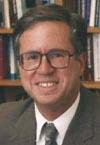General RelativityIn 1915, Einstein published the general theory of relativity. This is a theory of gravity which is consistent with special relativity. In it, matter and spacetime are interrelated physical phenomena. Matter moves along curved paths due to the curvature of spacetime. At the same time, spacetime is curved because of the presence and distribution of matter. Hence the theory is highly non-linear and interactive. Though it is incorporates special relativity, it assumes causal determinism: the present state determines the future state completely with no room for intrinsic chance (as in quantum physics). Thus it is philosophically classical regarding determinism / mechanism, but relativistic regarding spacetime. The simplest solutions to general relativity are for a single, point mass and for a uniform distribution of point masses. These lead to a variety of "black holes" solutions and include the classic tests of general relativity (e.g., the deflection of starlight by the sun and the shift in the perihelion of Mercury). Astronomers still debate the existence of black holes, but evidence mounts in their support. Another simple solution leads to Big Bang cosmology in its most basic form, where the point masses in the theory represent clusters of galaxies. This works because astronomers since the early 1920's have discovered that galactic clusters are in fact distributed evenly (homogeneously and isotopically) throughout the visible universe. Moreover the theory predicts that spacetime is either shaped like an expanding ball (the "closed" model) or like a flat or saddle-shaped surface (the "open" models). In the closed model, the universe will recollapse to zero size some 100 - 200 billion years form now. In the open models the universe expands and cools forever. The closed model has a finite size; in the open models, the universe is already infinite in size and still expands! In both cases, spacetime expands from an initial point called the Big Bang in which the size of the model is arbitrarily small, and the density and temperature of the matter soars to infinity. This strange event lies about 15 billion years in the past and is labeled the beginning of time, or "t=0". In the 1960's, it was shown that if the universe obeys certain conditions, the point t=0 is unavoidable, calling it an "essential singularity." Still it is a highly curious feature of science to predicate of the universe a ‘beginning’, an event which is the cause of future events, but not the effect of previous causes. A second curious feature of Big Bang cosmology involves what
is often called the "Anthropic Principle" (AP). The
AP starts with the observation that the evolution of life in the
universe is very closely connected with certain highly exact global
properties of the universe as a whole. Certainly scientists believe
that some form of life would arise by biological evolution given
the right planetary conditions. But since the mid 1970's, it has
become increasingly clear - and increasingly astonishing - that
had the universe as a whole been slightly different, those "right
planetary conditions" could never have arisen in the first
place! They focus their argument on the initial conditions of
the universe and the laws of nature, including the precise values
of the natural constants such as Planck’s constant and the
speed of light. Variations of even one part per million or less
would have produced a universe in which the development of galaxies,
stars, planets, organic molecules, and so on, would have been
highly unlikely, even impossible. Why then is the universe seemingly
‘fine-tuned’ for the eventual evolution of life? Big Bang cosmology includes additional challenges: why is there as much matter and antimatter in the universe, why is the universe at t=0 homogeneous and isotropic (the boundary question), why is the universe flat or only slightly open, etc. Recent work has modified Big Bang cosmology to address these and other challenges. Most scientists now believe that the very early universe expanded incredibly rapidly in what is called "inflation" and then settled down into the standard rate of expansion as described by the standard Big Bang model. According to the inflationary (or "hot") Big Bang models, we cannot be certain whether the universe began at a ‘t=0-like’ event or whether it emerged out of a prior megauniverse, inflating a tiny part of this pervious, perhaps eternal, superspace. Moreover, inflation may produce a vast number of distinct ‘domains’ each of which is like a universe of its own, each with different values of the natural constants, and so on. Could this account for the questions of ‘fine-tuning’ raised by the AP? Moreover, the very early universe, being nearly zero in size,
requires a quantum mechanical treatment and a theory of quantum
gravity to replace general. Hawking, Penrose, Valenkin, Isham,
and others have speculated that in such a model there would be
no initial singularity (no "t=0"). Moreover, just as
special relativity brought time and space together into spacetime,
so the combination of general relativity and quantum gravity could
further reduce the distinctiveness of time over against space
in these models of quantum gravity. Email link | Printer-friendly | Feedback | Contributed by: Dr. Robert Russell |







